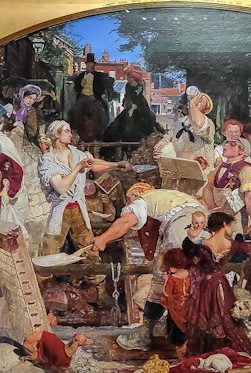Workers in London’s Hampstead and the historian Thomas Carlyle
I AM NOT A GREAT fan of the style of painting found in pictures by the Pre-Raphaelite artists. Although not a member of that artistic circle, Ford Madox Brown (1821-1893) created paintings in the Pre-Raphaelite style.
The Manchester Art Gallery contains a large collection of Pre-Raphaelite style paintings. Amongst these, one caught my attention. Entitled “Work”, it was painted between 1852 and 1865 by Ford Madox Brown. What interested me is that it depicts a scene in north London’s district of Hampstead.
 Detail from “Work”
Detail from “Work”“Work” depicts two labourers (‘navvies) digging a hole in the street as part of the preparations for laying sewers. In the background, there are houses that strongly resemble buildings that can be seen in Hampstead today. The painting was inspired by a book which Brown had read: “Past and Present” by the historian Thomas Carlyle (1795-1881) and published in 1843. The author discussed the nobility of labour in this book. Ford Madox Brown included a portrait of Carlyle on the right side of his painting. The canvas “Work” illustrates the contrast of the hard working labourers with the relatively wealthy, inactive bystanders.
An early study for Brown’s “Work” is his painting of Heath Street in Hampstead, which he created between 1852 and 1856 (https://artuk.org/discover/artworks/heath-street-hampstead-study-for-work-205501). The part of Hampstead depicted in “Work” is The Mount, which branches off Heath Street at an extremely acute angle. Brown had made a detailed study of the area in 1852.
Ford Madox Brown lived in many different places, including Manchester. However, I am not sure whether Hampstead was one of them until the end of his life. He did have a studio in Hampstead.He died in Primrose Hill (in his home at 1 St Edmunds Terrace), which is very close to Hampstead.
Lovers of Pre-Raphaelite artworks should not miss a visit to the Manchester Art Gallery. It should also appeal to those interested in modern architecture because the space between two parts of the institution has been roofed over and contains a interesting new staircase and a glass-floored bridge.
Depictions of Hampstead in painting always interest me because I was brought up in that neighbourhood and have researched it in detail whist preparing my book “BENEATH A WIDE SKY: HAMPSTEAD AND ITS ENVIRONS”. My title refers to the artist John Constable and his fascination with the cloudscapes that he could see from Hampstead, where he lived for many years .



